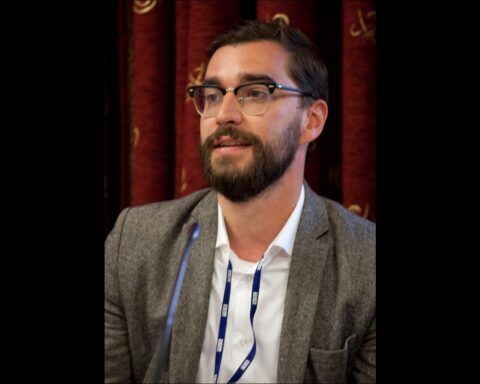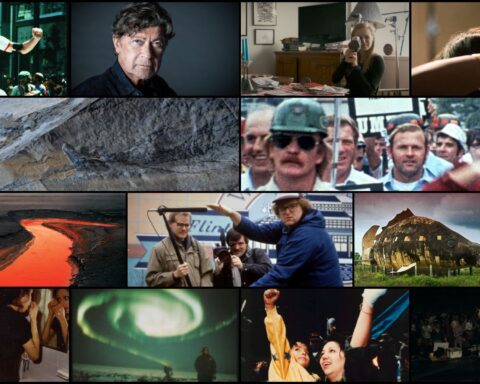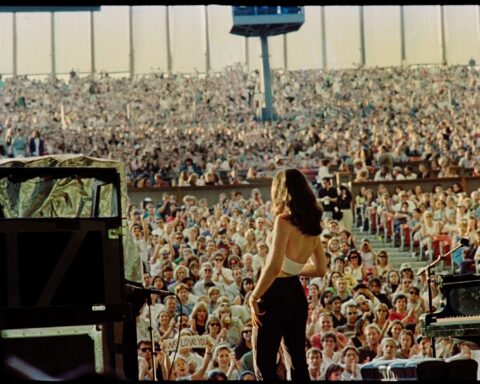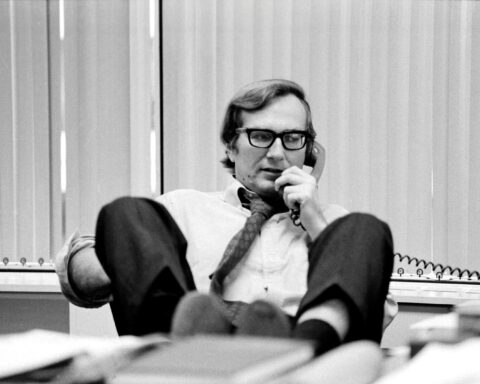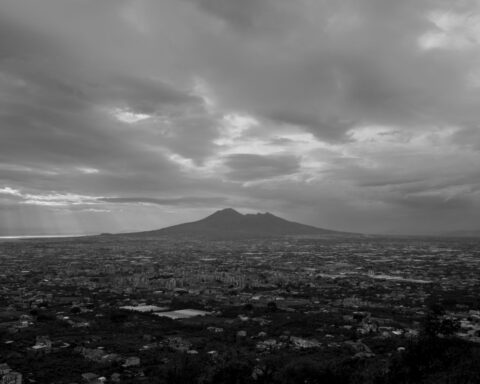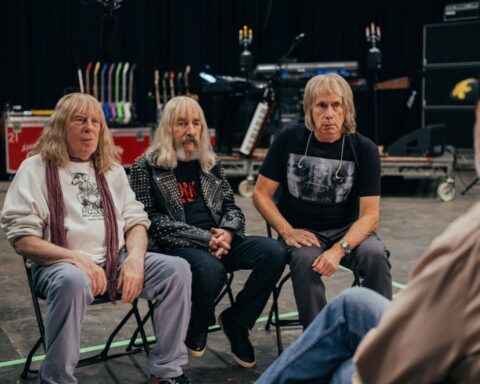THERE ARE TIMES WHEN MY LIFE IS ON THE PRECIPICE OF DEATH…IF I SHOW ANY WEAKNESS, I’M DEAD! —Timothy Treadwell, Grizzly Man
IF HE CAN GET THROUGH THIS SUIT, HE CAN HAVE ME, I’M DONE! —Troy Hurtubise, Project Grizzly
IF YOU ARE BOOKED FOR EXTINCTION THERE IS NOT MUCH YOU CAN DO ABOUT IT. —Will Cuppy, How To Become Extinct
Werner Herzog is a filmmaker of gargantuan scope and accomplishment: a wild man, an enigma, a dreamer, a seeker of truth, a teller of tales. His films examine the reality behind obsession, the extremes of human behaviour and the overwhelming power of nature. He sets forth to capture the unfilmable on film; he embarks on fantastical quests to the land of volcanoes, jungles, and the human mind. He penetrates our madness and revels in the folly of man’s grand designs.
Herzog has often talked of going beyond superficial reality to look for a deeper strata of images, an “ecstatic truth” with which to redefine reality. He has referred to filmmakers of the verité school as the “accountants of truth,” believing, as do most great artists, that imagination is necessary in order to reach a more profound truth. This is what has led him to often step outside the facts and hold his stories and characters up to larger sources of illumination. There is no hint of journalistic objectivity in his work: as he puts it, simply, “I am my films.”
I’ve often found Herzog to be a profound part of my own films as well. I seem to be attracted to similar sorts of quixotic characters, as well as to man’s uneasy relationship with nature and the animal kingdom. I even had a great-uncle who died of yellow fever (though some family members believe he drank himself to death) in the Amazon, looking for diamonds in the exact place where Herzog’s Fitzcarraldo (1982) was filmed, the same location where my grandmother came as a young girl from England to perform vaudeville for the men in the mining camps. As with Herzog’s notorious, near-apocalyptic relationship with Klaus Kinski, I have often wished that a terrible turn of events would happen to my subjects during filming, and that their story would come to an unfortunate end in the middle of the difficult dance that is the filmmaking process. I can recognize all too well Herzog’s compulsion to get up close to life: to experience the throb of existence, to go on impossible quests, to dream impossible dreams, to suspend the everyday world, to keep your demons at bay. One doesn’t watch a Herzog film, one is consumed with the intensity of a hurtling comet. Permit me to be terrified!
In Timothy Treadwell, the unforgettable subject of his film Grizzly Man (2005), Herzog finds some of the same madness that he saw, and indelibly utilized, in Kinski. He even places the two together, albeit obliquely, when he states in the film that “there is a family of men out there that Treadwell belongs to.” While it is thought that both Kinski and Treadwell suffered from bipolar maladies, this would be too trite a reason to explain Herzog’s fascination with such characters. “I love the jungle, but against my better judgment,” said Herzog in Burden of Dreams (1982). It’s a line that surely includes the human subjects that populate his films.
Largely constructed from Treadwell’s own videos of himself communing with the ursine inhabitants of Alaska’s Katmai National Park, five million acres of wilderness about 300 miles south of Anchorage, Grizzly Man constitutes one of Herzog’s most mysterious cinematic transmutations. It is more like a religious happening than a film; I almost hesitate to call it a documentary, for it is as rich and complex as any novel, not least for its melding of two narrators, or rather two auteurs. While Herzog clearly regards Treadwell’s one-with-nature rap with skepticism, if not scorn, as one filmmaker to another he clearly has deep admiration for the stunning images Treadwell brought back with him. The difference between the two filmmakers is one of approach: where Treadwell carried his L.A. media savvy with him into the wilderness, Herzog leaves long takes that Treadwell would have likely cut for the TV aesthetic he was driving for, enlarging the poetic human truth which his titular “grizzly man” was capturing irrespective of his own intentions.
Of course, Herzog could also relate to Treadwell’s mad spirit and his heedless, headfirst dive into the dark heart of nature. What could be more Herzogian than a man stepping off the template of the “normal,” cutting his own trail beyond the confines of any map? This is why Treadwell’s images appeal to Herzog: they reveal not only the fall of (a) man but the revelation of something new, and something ancient. Through the tragic “grizzly man,” Herzog found a truth beyond the formulaic nature shows which first brought this story to his attention—ironically, the type of show on which Treadwell wished to display his work.
Survival is at the core of animal behaviour and, in many respects, humans are no different. I believe Treadwell was trying to survive in the wild in order to find something pure, and that the bears he “befriended” represented something he had lost as a human being. Similarly, I think Herzog is a soul survivor in a way: he too is looking to find this enigma in his characters, to nurture the formation of a lost soul, to find sustenance, to be free and to get out alive.
In 1995, I directed a feature film called Project Grizzly, the story of a scrap-metal worker from North Bay who claims to have survived a grizzly attack, and builds protective suits of armour in order to encounter grizzlies at close quarters. I can recognize many similarities between my central character, Troy Hurtubise, and Herzog’s Treadwell.
Both are knight-errants at odds with the modern world; both view themselves as self-styled bear protectors, even claiming to understand the “language” of the bear; both seek to define their own territory outside of the everyday realities they normally inhabit. Both are clearly looking for a life on the edge—like many filmmakers I know, I might add.
Self-image, and self-promotion, was also a large part of Hurtubise’s and Treadwell’s endeavours. During the making of Project Grizzly, I once spoke to Troy about Treadwell, whose exploits he had followed. He said that Treadwell had it easier with the grizzlies at Katami, because they were well-fed compared to the hungrier, meaner grizzlies with whom Troy contended. While Hurtubise and Treadwell certainly fell on opposite sides of the masculine stereotype—Hurtubise envisioning himself as a combination of Clint Eastwood and Jacques Cousteau, while Treadwell has been described as a cross between St. Francis of Assisi and Christopher Guest’s Corky St. Clair in Waiting for Guffman —both had a fanatical need to prove that they could hold their ground with the bears. Troy’s obsession with taking a full grizzly impact upon his suit is not too far from Treadwell’s naked nuzzling with the beasts, or placing his tent in the middle of the bear’s path through the thick undergrowth which he referred to as “the grizzly maze.”
Hurtubise had his own version of the maze, “the cave,” in which he had a recurring dream where a native told him he was going to die at the hands of a grizzly. This echoes one of Treadwell’s final on-camera confessions, where he states that he has had a premonition of his own death—which he then shrugs off with the maxim “Live faster! Die faster! I love this!” These scenes show the complexity of Troy and Timothy’s psychological identification with the bears: on the one hand, a feeling of almost brotherly kinship; on the other, a strange, driving force pushing them into ever closer, and dangerous, proximity with their animal ‘brothers’—a force which some might describe as a death wish. And while the swaggering Hurtubise has not (yet) realized the fate set out for him in his death dream (he apparently still lives in North Bay, a donut store Quixote forever working on his new and improved bear armour), the fey Treadwell ultimately seemed to surrender his body—in a particularly horrifying manner—to the primordial forces of nature, like Joseph Conrad’s Kurtz.
Such comparisons would not be too far outside Treadwell’s grandly narcissistic image of himself. While he claims to be protecting the bears, watching him patrolling grizzly territory with his fox friend Tim reveals that he is protecting his own self, and his own sanity, as much as the bears. An ex-surfer and failed actor with a history of alcoholism and substance abuse, Treadwell finally found his life’s mission with the Alaskan grizzlies. (“Before I had these bears I was nothing,” he says.) This would explain his AA-style zeal, and his need to find something larger than himself in life, a largeness which would then, of course, enlarge his own self by his immersion in it.
Treadwell’s romanticizing of nature was founded on a simultaneous idealization of himself as both godlike protector of the bears and a “humble servant” in nature’s divine plan. A particularly revealing moment has Treadwell imploring the heavens and whatever deity he can think of (Buddha included) to bring the rains to end a drought; when it does rain shortly thereafter, he claims responsibility and strikes a mock-heroic victory stance in the downpour, like a triumphant medicine man.
Unfortunately, these gestures seem to go mostly unappreciated by Treadwell’s self-willed charges. While some of the grizzlies did learn to tolerate Treadwell, it was most likely when their bellies were full of salmon. In the way that even street gangs will skirt around a mentally impaired person raving on the street out of either fear or pity, it is possible these bears thought Treadwell was crazy and left him alone for the same reason. Ascribing such human motives to the bears, however, was Treadwell’s cardinal error. Refusing to view them as animals, with their own, distinctly non-human imperatives, Treadwell sought to make the bears a part of his own personalized cosmos, a self-made world which was suddenly, horribly shattered when an older, meaner grizzly—no longer sated by the abundant salmon of the summer months—mauled and devoured Treadwell and his girlfriend Annie Huguenard in 2003. When the bear was located and killed, Treadwell’s wrist watch was found in its belly, still ticking on his severed hand. It’s a poignant artifact left by a man trying to escape the spatial time constraints of his life.
While Herzog is naturally drawn to doomed protagonists, he sees nothing glorious in Treadwell’s death. Yet neither does he view it as a fitting, or deserved, end, as do some of his interviewees. Herzog clearly, even stridently, rejects Treadwell’s anthropomorphized, Disney- fied view of nature; still, there is a part of him which understands the call to which Treadwell responded, as well as the perilous undertow of that obsession which Treadwell, in his more introspective moments, clearly realized. Herzog admired Treadwell’s attempt at the great adventure into the unknown, that place where new and potent images come from, and which Treadwell, even in his relentless self-aggrandizement, was able to recognize and capture. The last images Herzog shows us in Grizzly Man, of Treadwell walking upriver with the grizzlies, his fox friend at his side, rips my heart wide open. It will forever be burned in my memory, and it is as beautiful as any image I have ever seen. Somehow, it magically carries with it the primacy and power of the whole film, as well as Treadwell’s bizarre, tragic, and revelatory life.




